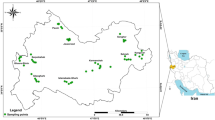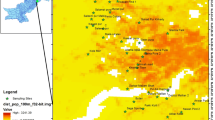Abstract
Heavy metals in soils are of great environmental concern, in order to evaluate heavy metal contents and their relationships in the surface soil of industrial area of Baoji city, and also to investigate their influence on the soils. Soil samples were collected from 50 sites, and the concentration of Pb, Zn, Cu, Cr, Ni heavy metals and the contents of characteristics in soil from industrial area of Baoji city were determined with X-ray fluorescence method. The concentrations of Pb, Zn, Cu, Cr and Ni in the investigated soils reached the amount of 2,682.00–76,979.42, 169.30–8,288.58, 62.24–242.36, 91.96–110.54 and 36.14–179.28 mg kg−1, respectively. The major element Pb contents of the topsoils were determined. to highlight the influence of ‘anthropic’ features on the heavy metal concentrations and their distributions. To compare, all values of elements were much higher than those of unpolluted soils in the middle of Shaanxi province that average 16.0–26.5, 67.1–120.0, 17.8–57.0, 46.9–65.6 and 24.7–34.6 mg kg−1 for Pb, Zn, Cu, Cr and Ni, respectively. An ensemble of basic and relativity analysis was performed to reduce the precipitate of Pb in soil was extremely high and greatly relativity with other elements. Meanwhile, Pb, Zn, Cu, Cr, Ni heavy metals were typical elements of anthropic activities sources, so it was easy to infer to the tracers of anthropic pollutions from the factorial analysis, which was coming from the storage battery manufactory pollutions. The pollutant distributions were constructed for the urban area which identified storage battery manufactory soot precipitate as the main source of diffuse pollution and also showed the contribution of the topsoils of industrial area of Baoji city as the source point of pollution. Consequently, the impact of heavy metals on soil was proposed and discussed. These results highlight the need for instituting a systematic and continuous monitoring of heavy metals and other forms of pollutants in Baoji city to ensure that pollution does not become a serious problem in the future.



Similar content being viewed by others
References
Churl GL, Hyo-Taek C, Myung CJ (2001) Heavy metal contamination in the vicinity of the Daduk Au–Ag–Pb–Zn mine in Korea. Appl Geochem 16:1377–1386
David SW (1998) The impact of unconfined mine tailings and anthropogenic pollution on a semi-arid environment—an initial study of the Rodalquilar mining district, south east Spain. Environ Geochem Health 20:29–38
Davis JC (1986) Statistics and data analysis in geology, 2nd edn. Wiley, New York
Dianne KN, Jillian FB (2002) Geomicrobiology: how molecular-scale interactions underpin biogeochemical systems. Science 296(10):1071–1077
Dosanjos MJ, Lopes RT, de Jesus EFO, Assis JT, Cesareo R, Barradas CAA (2000) Quantitative analysis of metals in soil using X-ray fluorescence. Spectrochim Acta B 55:1189–1194
Faruque A, Hawa MB, Monsur MH, Hiroaki I (2005) Present environment and historic changes from the record of lake sediments, Dhaka City, Bangladesh. Environ Geol 48:25–36
GB15618-1995 (1995) Soil environment quality standards of People’s Republic of China. Standards Press of China, Beijing
Govil PK, Reddy GLN, Krishna AK (2001) Contamination of soil due to heavy metals in the Patancheru industrial development area, Andhra Pradesh, India. Environ Geol 41:461–469
Hartyáni Z, Dávid E, Szabó S, Szilágyi V, Horváth T, Hargitai Tóth A (2000) Determination of the trace elements distribution of polluted soils in Hungary by X-ray methods. Microchem J 67:195–200
Hendershot WH, Lalande H, Duquette M (1993) Soil reaction and exchangeable acidity. In: Carter MR (eds) Soil sampling and methods of analysis for Canadian Society of Soil Science. Lewis, Boca Raton, pp 141–145
Imre S, Jáos O, René E, Van G (2004) X-ray spectrometry. Anal Chem 76:3445–3470
Jdid EA, Blazy P, Kamoun S, Guedria A, Marouf B, Kitane S (1999) Environmental impact of mining activity on the pollution of the Medjerda River, north-west Tunisia. Bull Eng Geol Environ 57:273–280
Julie M, Alex BM (2001) A review of the contamination of soil with lead II. Spatial distribution and risk assessment of soil lead. Environ Int 27:399–411
Kabata-Pendias A, Pendias H (1992) Trace elements in soils and plants, 2nd edn. CRC, Boca Raton, pp 150–156
Krishna AK, Govil PK (2005) Heavy metal distribution and contamination in soils of Thane–Belapur industrial development area, Mumbai, Western India. Environ Geol 47:1054–1061
Latinka S, Biljana K, Nada M, Antonije O (2004) Principal component analysis of trace elements in industrial soils. Environ Chem Lett 2:105–108
Li XP, Huang CC (2006) Study on the soil environment pollution in City Industry Zone: XRF (in Chinese). Soils (in press)
Li XP, Huang CC, Pang JL (2005) A rapid and simultaneous detection heavy metal pollutants in soil around storage cell manufactory: XRF spectroscopy (in Chinese). Phys Test Chem Anal B Chem Anal, XRF Spec Issue 41:83–86
Pan A-F, Vine HE, Run-von MA (2004) Zoning of environmental geochemistry in Shaanxi province. Adv Earth Sci 19:339–443
Pang JL, Zhang J, Huang CC (2003) Rapid determination of total organic carbon in soil and loess saples by High TOC II analyzer (in Chinese). Anal Instrum (1):34–37
Ratha DS, Sahu BK (1993) Source and distribution of metals in urban soil of Bombay, India, using multivariate statistical techniques. Environ Geol 22:276–285
Reimann C, De CP (1998) Chemical elements in the environment. Springer, Berlin Heidelberg New York
Sanchez J, Marino N, Vaquero MC, Ansorena J, Legorburu I (1998) Metal pollution by old lead-zinc mines in Urumea river valley (Basque Country, Spain) soil, biota and sediment. Water Air Soil Pollut 107:303–319
Sutherland RA (2000) Depth variation in copper, lead and zinc concentrations and mass enrichment ratios in soil so fan urban water shed. J Environ Qual 29:1414–1422
Tiller KG (1992) Urban soil contamination in Australia. Aust J Soil Res 30:937–957
Tuchschmid MP, Dietrich V, Richner P, Lienemann P, Desaules A, KuÈndig R, Vogler R (1995) Federal Office of Environment, Forests and Landscape (BUWAL). Umweltmaterialien Nr. 32, Bern
Wei F (1990) Elemental background contents in the soil of China. China Environmental Science Press, Beijing
Zhang H, Ma D, Xie Q, Chen X (1999) An approach to studying heavy metal pollution caused by modern city development in Nanjing, China. Environ Geol 38(3):223–228
Zhang XF, Lin YS, Yu F, Li B (2005) Pollution of heavy metals in urban soils of typical industrial and surrounding residential area in Nanjing city. Resour Environ Yangtze Basin 14(4):512–515
Zhou CY, Wong MK, Kon LL, Wee YC (1997) Soil lead and other metal levels in industrial residential and nature reserve areas in Singapore. Environ Monit Assess 44:605–615
Acknowledgments
We are sincerely thankful for the Funds provided by Youth Science Fund of Shaanxi Normal University (2005) and National Natural Sciences Foundation of China (No. 40571154), and also, many thanks to Dr Philip La Moreaux Editor-in-Chief, Environmental Geology and many anonymous referees and editors for previewing and providing English writing helps.
Author information
Authors and Affiliations
Corresponding author
Rights and permissions
About this article
Cite this article
Li, X., Huang, C. Environment impact of heavy metals on urban soil in the vicinity of industrial area of Baoji city, P.R. China. Environ Geol 52, 1631–1637 (2007). https://doi.org/10.1007/s00254-006-0608-3
Received:
Accepted:
Published:
Issue Date:
DOI: https://doi.org/10.1007/s00254-006-0608-3




